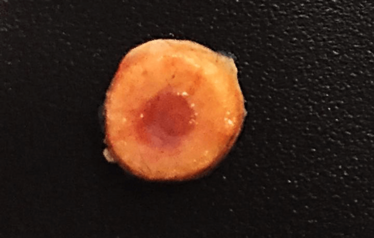Bone marrow transplants are not pleasant for patients. Irradiation and, in some cases, cytoreductive therapy are required to prepare the patient by killing host stem cells – a process with significant potential side effects, ranging from nausea and fatigue to a loss of fertility.

Figure 1. Engineered bone with functional marrow. Image credit: Varghese lab, UC San Diego.
Could lab-grown bone hold the key? Researchers at the University of California San Diego have developed a synthetic biomaterial that matures into functional bone (1) with hematopoietic activity with the introduction of donor bone marrow cells (see Figure 1). Implanted beneath the skin, the biomimetic matrix provides support for the donor cells to grow without competition from host cells, so drugs and radiation dosing are not required. So far, the implant has shown promise in mice; after four weeks, the engineered bone tissue contained both host and donor blood cells – and after six months, the host/donor mix was still present in the bloodstream, indicating that the new bone marrow remains functional.
There are limitations – the implant would not be suitable for the treatment of malignant diseases that require the elimination of cancerous cells. But the authors do see its potential in treating other bone-marrow diseases, such as aplastic anemia, where there is an insufficient supply of blood cells. And they also believe the engineered bone could be used as a platform to study hematopoiesis and the impact of disease.
- Y Shih et al., “In vivo engineering of bone tissues with hematopoietic functions and mixed chimerism”, Proc Natl Acad Sci, [Epub ahead of print] (2017). PMID: 28484009.

I have an extensive academic background in the life sciences, having studied forensic biology and human medical genetics in my time at Strathclyde and Glasgow Universities. My research, data presentation and bioinformatics skills plus my ‘wet lab’ experience have been a superb grounding for my role as a deputy editor at Texere Publishing. The job allows me to utilize my hard-learned academic skills and experience in my current position within an exciting and contemporary publishing company.















